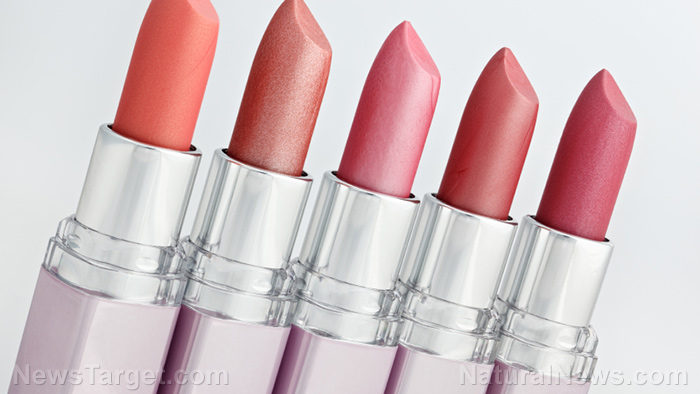 Parler
Parler Gab
Gab
- Iron oxides are natural or synthetic pigments (red, yellow, black) used in cosmetics like lipstick, foundation and sunscreen. They are stable and long-lasting but may contain trace heavy metals (arsenic, lead, mercury) from mining or production.
- Potential health risks of iron oxides include heavy metal contamination since even small amounts of toxic metals can build up in the body over time.
- Additionally, powdered makeup (blush, eyeshadow) can irritate the lungs if inhaled. Some people may experience allergic reactions or irritation when exposed to iron oxides.
- While short-term use is considered safe, the long-term effects of iron oxides are unclear. Safer alternatives to iron oxides include mica-based makeup (though ethical concerns exist with mining). Other alternatives include plant-based pigments (beetroot, turmeric), but they may not last as long. Non-tinted options include mineral sunscreens (zinc oxide, titanium dioxide).
- While iron oxides are widely used and generally considered safe, potential risks, especially from contamination, mean consumers should stay informed and consider alternatives if needed.
What are iron oxides?
Iron oxides are chemical compounds composed of iron and oxygen, occurring naturally in minerals such as hematite (red iron oxide, Fe₂O₃), magnetite (black iron oxide, Fe₃O₄) and goethite (yellow iron oxide, FeO(OH)). They can also be synthesized in laboratories to achieve greater purity and consistency. These pigments are prized for their stability, opacity and resistance to light and heat, making them a staple in the cosmetic industry. Consumers scanning ingredient lists may encounter iron oxides under various names, including:- CI 77491 (Iron Oxide Red)
- CI 77492 (Iron Oxide Yellow)
- CI 77499 (Iron Oxide Black)
- Ferric oxide
- Natural iron oxides (often mined from mineral deposits)
Toxicity of iron oxides
While regulatory bodies like the Food and Drug Administration (FDA) and the European Commission (EC) classify iron oxides as generally safe for topical use, emerging research suggests potential concerns:Contamination with heavy metals
Natural iron oxides are often mined from the earth, where they can be contaminated with toxic heavy metals such as arsenic, lead and mercury. Even synthetic versions, though purer, may still contain trace impurities. Chronic exposure to these contaminants can lead to bioaccumulation and long-term health effects. (Related: Harmful ingredients in personal care products.)Inhalation risks in powdered forms
Loose mineral makeup, eyeshadows and blushes containing iron oxide powders pose an inhalation hazard. Fine particulate matter can get lodged in the lungs, potentially causing respiratory irritation or contributing to lung damage over time.Skin sensitivity and allergic reactions
Though rare, some individuals may experience contact dermatitis or irritation from iron oxides, particularly at high concentrations. Those with sensitive skin or metal allergies should exercise caution when dealing with products that may contain iron oxides.Lack of comprehensive safety data
Despite their widespread use, iron oxides have not undergone extensive long-term toxicological studies. The Cosmetic Ingredient Review (CIR) panel acknowledges that while short-term exposure appears safe, the effects of prolonged, daily use remain uncertain.What are iron oxides used for?
Iron oxides are found in a staggering array of beauty and personal care products, including:- Eyeshadows and eyeliners – Used to create bold, pigmented looks.
- Foundations and concealers – Used to match skin tones and provide coverage.
- Lipsticks and lip balms – Used to impart long-lasting, opaque color.
- Mascaras and brow products – Used to enhance definition and depth.
- Sunscreens and mineral powders – Used to provide tinted UV protection.
Alternative products without iron oxides
For consumers seeking safer options, several natural alternatives exist:- Mica-based mineral makeup – While mica has its own ethical concerns (e.g., child labor in mining), it is often considered a cleaner alternative when ethically sourced.
- Plant-based colorants – Alternatives like beetroot powder, turmeric and spirulina offer natural pigments, though they may lack the same vibrancy and longevity.
- Titanium dioxide and zinc oxide – Used in untinted mineral sunscreens and foundations, these provide color without iron oxides.
How to detox from iron oxides
Given that iron oxides are not absorbed systemically through the skin in significant amounts, "detoxing" from them is largely unnecessary. However, those concerned about heavy metal exposure may consider:- Supporting liver function – A healthy liver naturally filters toxins, so maintaining a balanced diet rich in antioxidants may aid in detoxification.
- Switching to iron oxide-free cosmetics – Opt for products that use plant-derived or mineral-based pigments.
- Using chelating agents – Certain supplements (e.g., cilantro, chlorella) are purported to help remove heavy metals, though scientific evidence is limited.
More related stories:
Study: Toxic FOREVER CHEMICALS are found in many cosmetics. Consumer beware: Harmful ingredients in toothpaste and natural alternatives you can use. FDA finally takes action on toxic Red Dye 3. Sources include: Brighteon.AI NaturalNews.com Brighteon.comHealth Ranger demonstrates real-time reality alteration through crystallography experiments
By Finn Heartley // Share
Joe Biden diagnosed with aggressive PROSTATE CANCER
By Belle Carter // Share
Top FDA official reveals she didn’t get the COVID-19 injection
By Ramon Tomey // Share
FBI leaders unveil cached “Russiagate” files, unmasking agency overreach amid rocky reforms
By Willow Tohi // Share
Governments continue to obscure COVID-19 vaccine data amid rising concerns over excess deaths
By patricklewis // Share
Tech giant Microsoft backs EXTINCTION with its support of carbon capture programs
By ramontomeydw // Share
Germany to resume arms exports to Israel despite repeated ceasefire violations
By isabelle // Share










